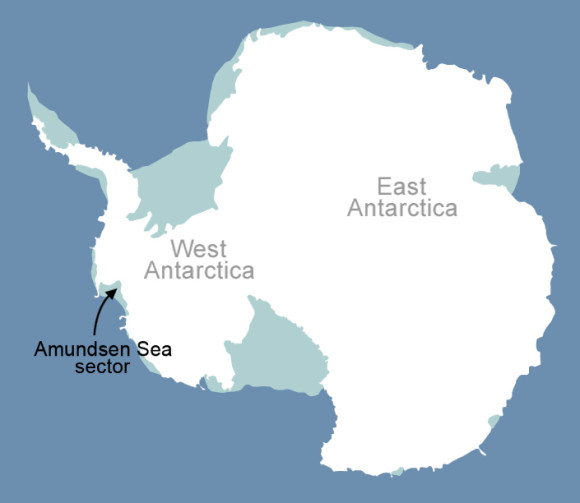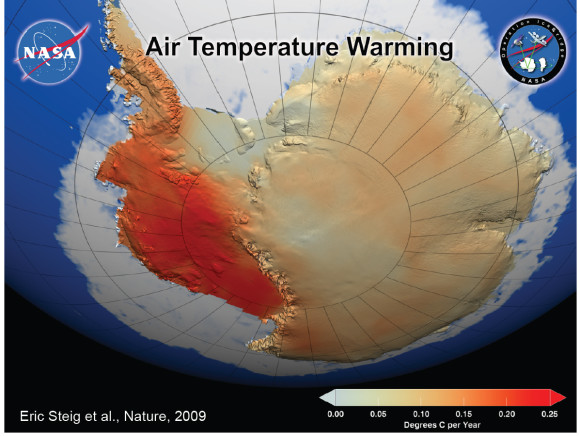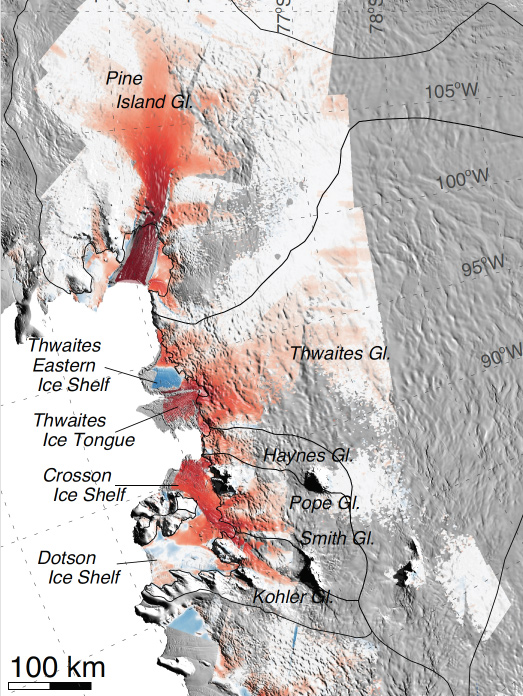In a new report issued by NASA and the University of California, Irvine yesterday (May 12, 2014), six major glaciers in the West Antarctic ice sheet have “passed the point of no return” with respect to melting into the sea. These scientists say glacial ice in this part of Antarctica is in “an irreversible state of decline.” The complete melting of the six glaciers in this study – not expected to occur for some centuries – would raise global sea level by four feet (1.2 meters). The work is based on 40 years of observations, analyzing the glaciers in the Amundsen Sea sector of West Antarctica. It has been accepted for publication in the journal Geophysical Research Letters.
The NASA/UC Irvine study is one of two studies on melting ice in Antarctica released on May 12. The other study, published May 12 in Science, focused specifically on one glacier in this region – the Thwaites glacier on the Amundsen Sea. It was thought to be “stabilized for a few thousand years,” but now is expected to collapse into the sea faster than that, on the order of 200-900 years. In other words, the two studies confirm each other’s results.


Unlike the Arctic, which is an ocean surrounded by continents, Antarctica is a continent surrounded by an ocean. That is why Earth’s two polar extremes are responding differently to global warming; they are very different places. Antarctica is a large land mass that is covered with ice that moves toward the sea in what are called ice streams.
In recent years, although in general there has been extensive ice growth in the ocean around the Antarctic continent, the Amundsen Sea sector of West Antarctica has been experiencing ice loss. For example, NASA has been tracking the huge ice island B31, which broke away from West Antarctica’s Pine Island Glacier in November 2013.
The Amundsen Sea region is sometimes called “the weak underbelly of the West Antarctic ice sheet” because most of the ice sheet is grounded on a bed that lies below sea level. That means that ocean currents can deliver warm water to glacier grounding lines in this region, that is, to the place where the ice attaches to solid ground (in this case, the seabed).
This makes them vulnerable to more rapid melting than the rest of the Antarctic continent.

The NASA/UC Irvine study points to three primary lines of evidence that cause scientists to believe the glaciers will continue to melt into the sea over time.
- The change in flow speeds of the ice along the Western Antarctic coast. Over the past 40 years, the flow speeds of these glaciers have been increasing.
- The slope of the terrain the glaciers are flowing over, and that terrain’s depth below sea level. All the glacier beds slope deeper below sea level as they extend farther inland. As the glaciers retreat, they cannot escape the reach of the ocean, and the warm water will keep melting them even more rapidly.
- How much of each glacier floats on seawater. Nearly all glacier melt occurs on the underside of a glacier, on its forward section, on the part that is floating on seawater. The NASA/UC Irvine study found that glaciers in West Antarctica have stretched out and thinned over the past 40 years, so that they are now floating in places where they used to sit on land. Thus they are melting more rapidly.
Earth’s oceans are getting warmer, and warmer ocean waters are contributing to the loss of Antarctic glacial ice over time. But there is one key cause to Antarctic glacial melting, and that is shifting winds. Stronger winds are pushing warm water under coastal glaciers and melting them, scientists say. That process is expected to intensify in the coming decades. Read more about the effect of wind at National Geographic.
Glaciologist and lead study author Eric Rignot of UC Irvine and NASA’s Jet Propulsion Laboratory (JPL) in Pasadena, California spoke about his team’s findings:
The collapse of this sector of West Antarctica appears to be unstoppable. The fact that the retreat is happening simultaneously over a large sector suggests it was triggered by a common cause, such as an increase in the amount of ocean heat beneath the floating sections of the glaciers. At this point, the end of this sector appears to be inevitable.
In an excellent background piece on West Antarctica, released by NASA JPL on May 12, Patrick Lynch of NASA’s Earth Science News Team wrote:
The most recent U.N. Intergovernmental Panel on Climate Change (IPCC) report estimates that by 2100, sea level will rise somewhere from just less than 1 foot to about 3 feet (26 to 98 centimeters). But the vast majority of these projections do not take into account the possibility of major ice loss in Antarctica. Rignot said this new study suggests sea level rise projections for this century should lean toward the high-end of the IPCC range.
Bottom line: Research conducted by NASA And the University of California, Irvine, shows that the melting of six glaciers in the Amundsen Sea sector of West Antarctica is unstoppable and has passed the point of no return. If they all melt, seal level rise could increase by four feet, or roughly 1.2 meters.











